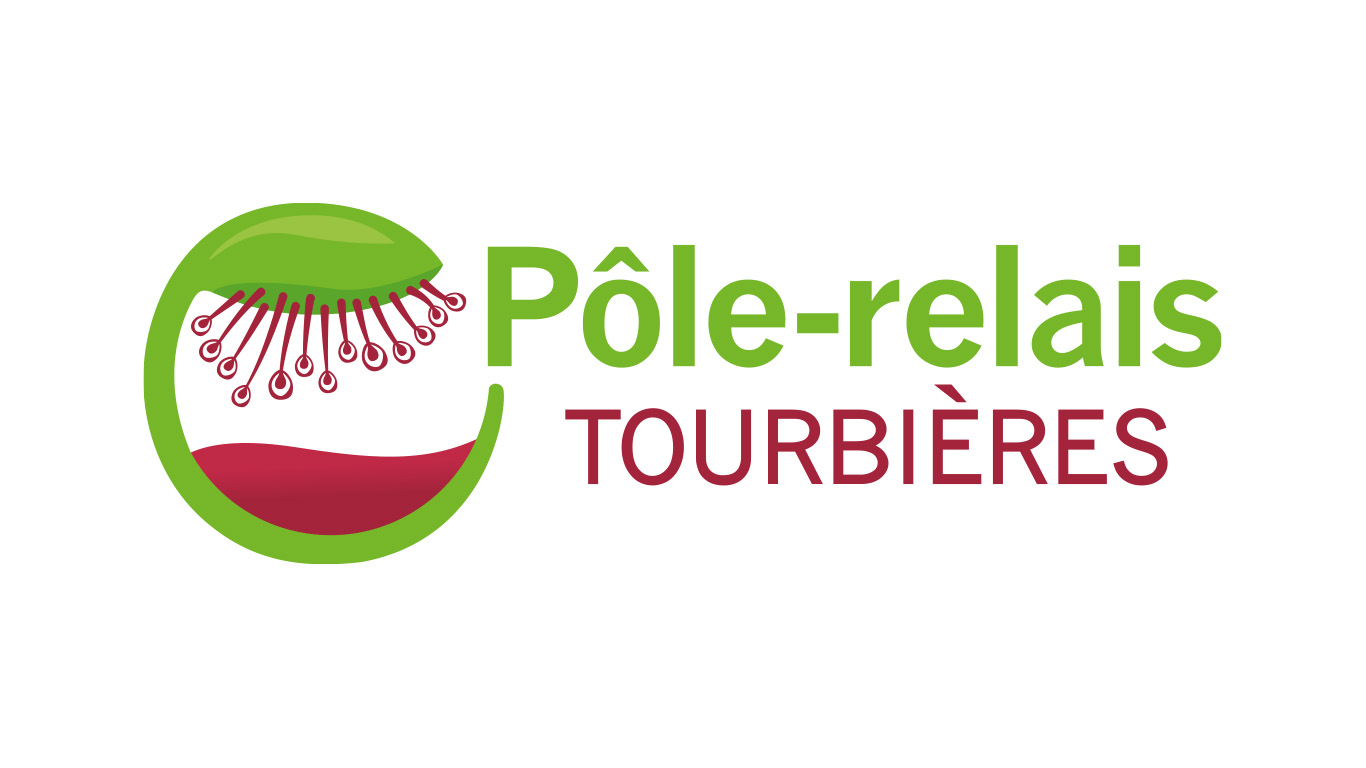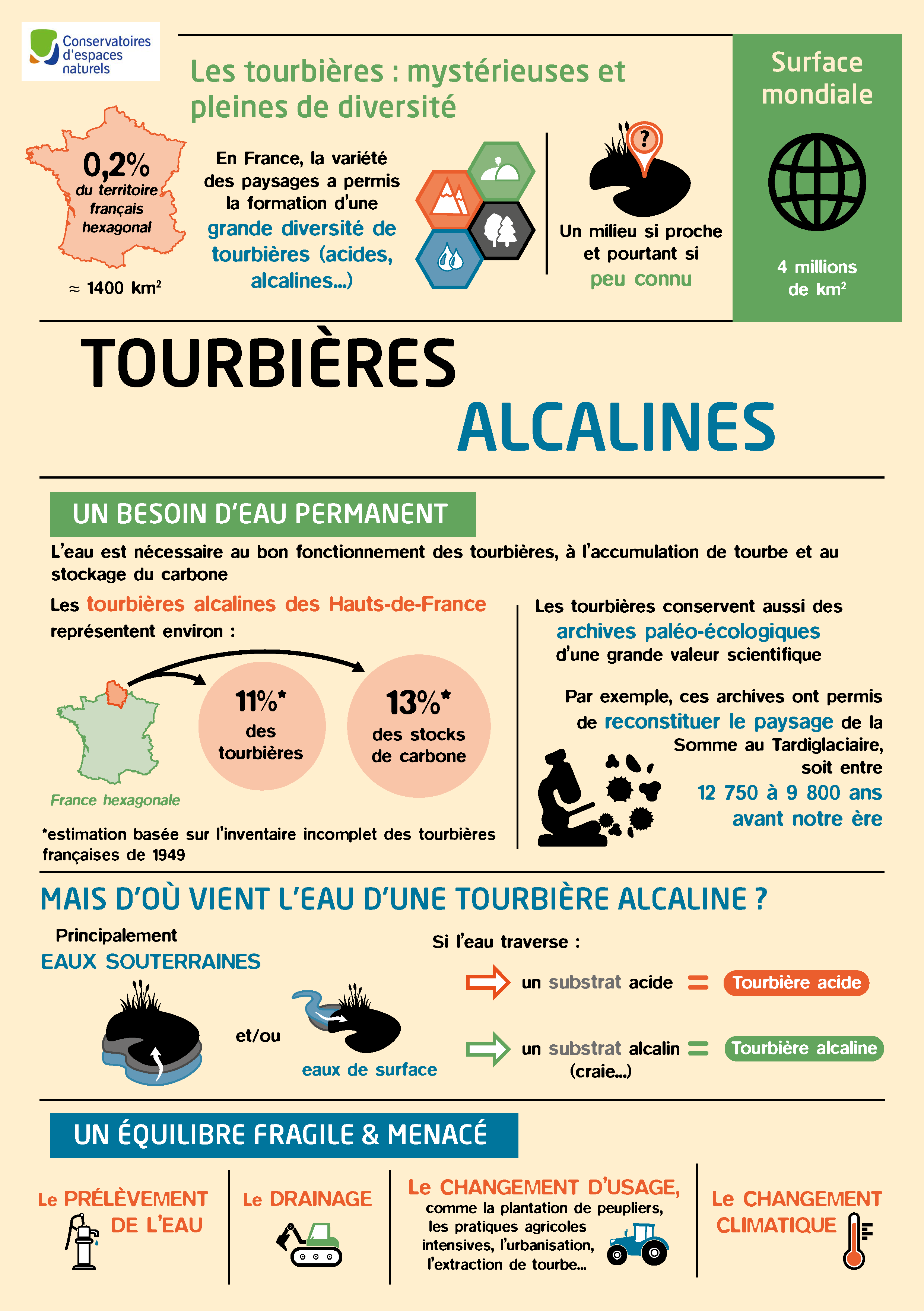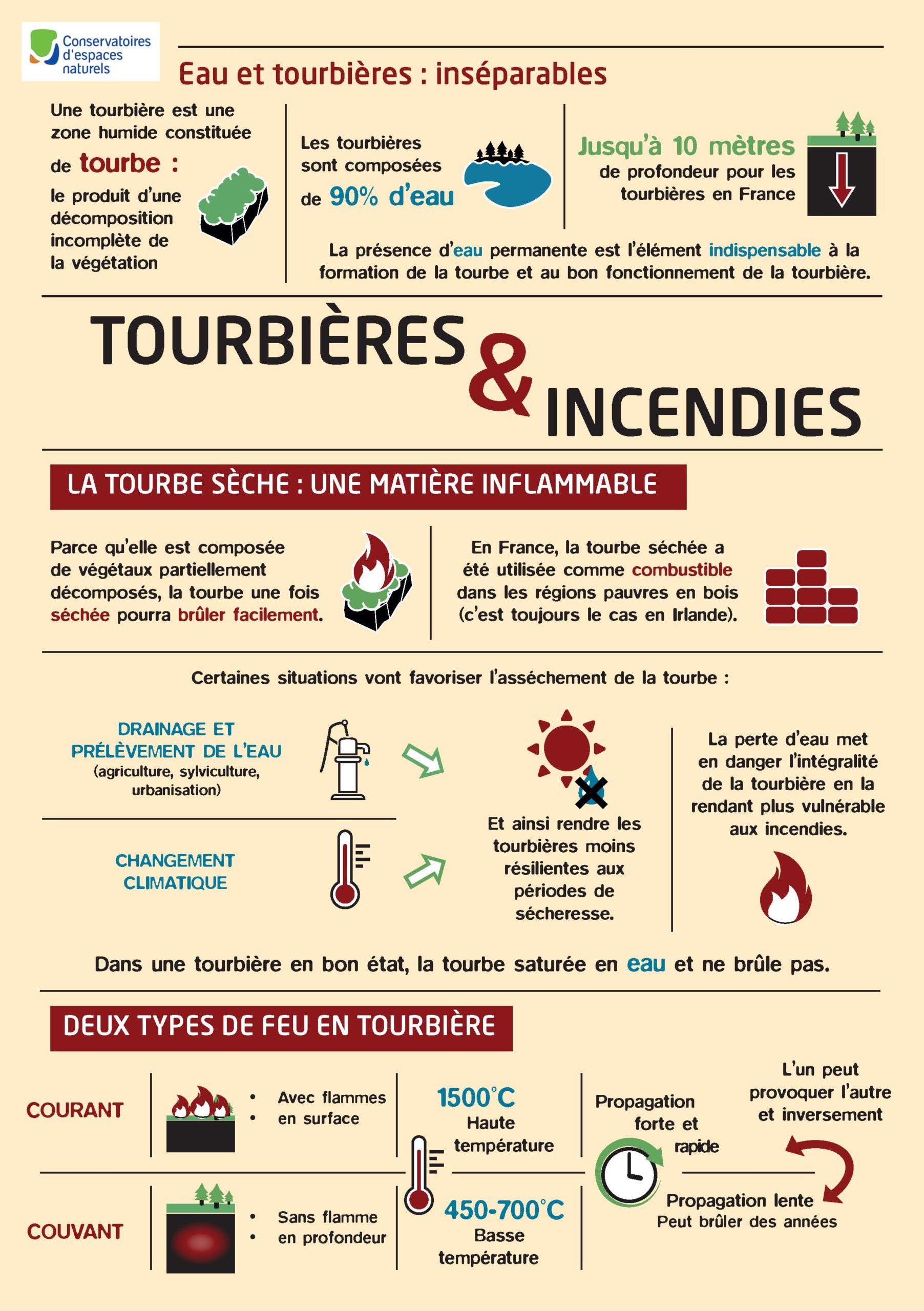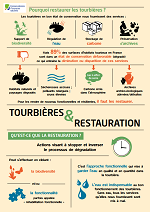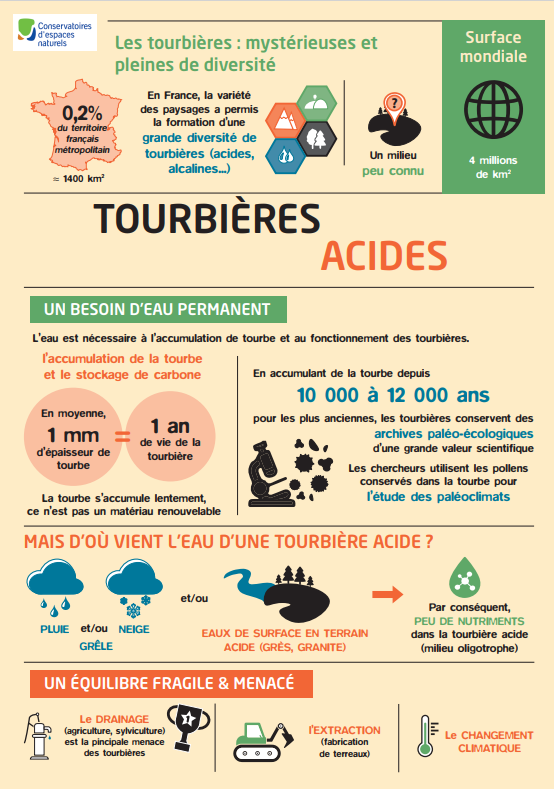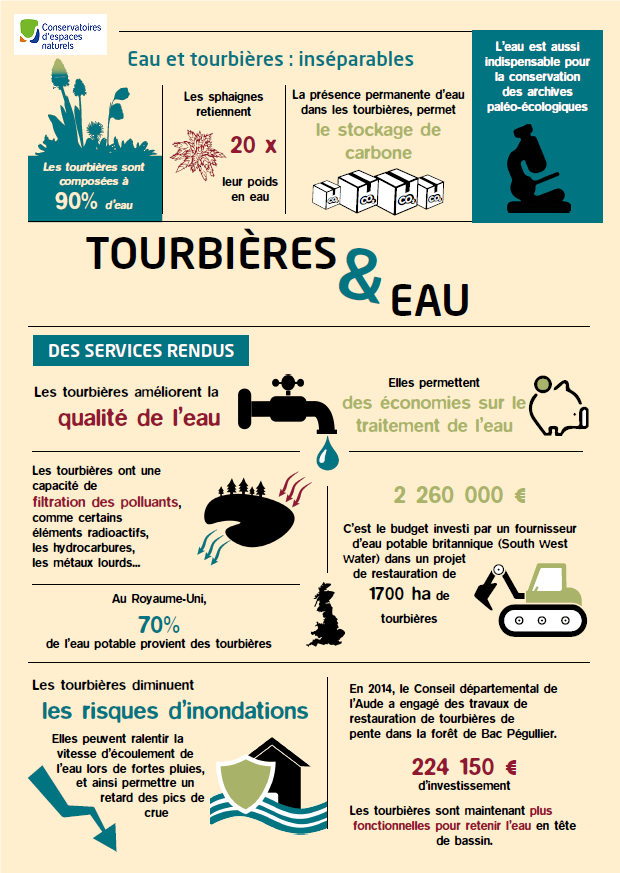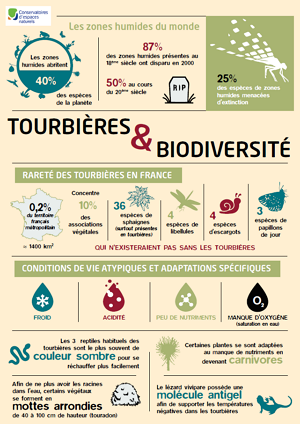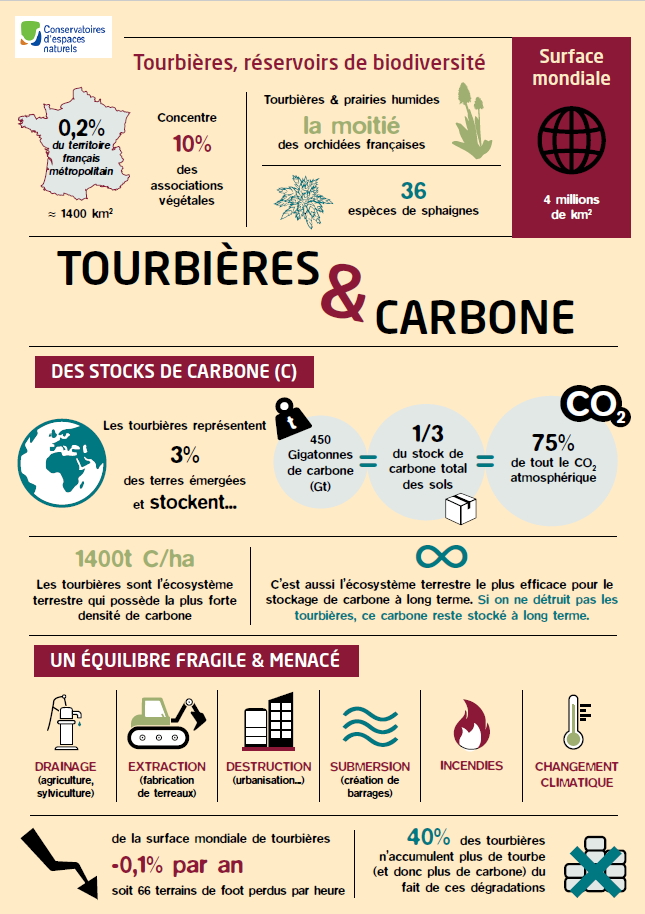Retrouvez les références bibliographiques de chacune des infographies produites par le Pôle-relais tourbières :
Tourbières alcalines
- Catteau, E. ; François, R. ; Prey, T. ; Farvacques, C. (2017). Analyse d’un système de végétations menacées : les tourbières neutro-alcalines du nord-ouest de la France, Documents phytosociologiques – Actes du colloque de Saint-Mandé 2012 – Prodrome et cartographie des végétations de France – Vol. 6
- Crassous, C. ; Karas, F. (2007). Tourbières et marais alcalins des vallées alluviales de France septentrionale. Guide de gestion. Fédération des Conservatoires d’espaces naturels ; Pôle-relais tourbières. p. 19-27.
- François, R. (2021). Les 15 000 hectares de tourbières alcalines des vallées de Somme et d’Avre (Picardie) : Première partie, milieu physique et géohistoire. Bulletin de la Société Linnéenne Nord-Picardie, 39, 77.
- Garcia, C. (2024). L’étude des tourbes et caractérisation des paléo-environnements de la vallée de la Somme, Colloque du Groupe d’Etudes des Tourbières 2024. https://www.youtube.com/watch?v=beSuHdnhFug
- Manneville, O. (1999). Le monde des tourbières et des marais : France, Suisse, Belgique et Luxembourg. Delachaux & Niestle.
- Marescaux, Q. ; Lebrun, J. ; Gaudin, G. (2021). Plan régional d’actions en faveur des tourbières des Hauts-de-France 2022-2031. Conservatoire d’espaces naturels des Hauts-de-France, Agence de l’Eau Artois-Picardie (AEAP), Agence de l’Eau Seine-Normandie (AESN), DREAL Hauts-de-France, 63 p + annexes.
- Muller, F. Comm. pers. 25 février 2022
- Pinault, L. et al. (2023) The 1949 atlas of French peat deposits, a starting point for a National Inventory of Peatlands, Soil Use and Management, 39(3), pp. 1040–1056. doi:10.1111/sum.12919.
Sources de la carte au verso :
- Commissariat Général au Développement Durable, Service de l’Observation et des Statistiques, (2013). Fiches descriptives de massifs à tourbières de France métropolitaine.
- Conservatoire Botanique National du Bassin Parisien, (2013). Cartographie des habitats.
- Conservatoire d’espaces naturels des Hauts-de-France, (2017). Inventaire des tourbières de Picardie.
- Conservatoire d’espaces naturels de Normandie ; Conservatoire Botanique National de Brest, (2020). Inventaire des tourbières de Normandie.
- Forum des Marais Atlantiques, (2022). Inventaire des zones humides du bassin versant de la Semoy.
- Institut national de l’information géographique et forestière (2024). Données administratives. https://geoservices.ign.fr/adminexpress
- Ministère de l’industrie et du commerce ; Gilbert, D. ; Muller, F. ; Bernard, G. ; Pilloix, M. (2021). Inventaire numérisé des tourbières françaises de 1949.
Tourbières & incendies
- Azmi, N. ; Mohd Apandi, N. ; & Rashid, A. (2021). Carbon emissions from the peat fire problem – A review. Environmental Science and Pollution Research, 28, p. 1‑14. https://doi.org/10.1007/s11356-021-12886-x
- Datta, A. ; Krishnamoorti, R. (2022). Understanding the Greenhouse Gas Impact of Deforestation Fires in Indonesia and Brazil in 2019 and 2020. Frontiers in Climate, 4. https://www.frontiersin.org/articles/10.3389/fclim.2022.799632 (Consulté le 01/06/2024)
- Hein, L. ; Spadaro, J. V. ; Ostro, B. ; Hammer, M. ; Sumarga, E. ; Salmayenti, R. ; Boer, R. ; Tata, H. ; Atmoko, D. ; Castañeda, J.-P. (2022). The health impacts of Indonesian peatland fires. Environmental Health, 21(1), 62 p. https://doi.org/10.1186/s12940-022-00872-w
- Heinrich Böll Stiftung. (s. d.). Peatland Atlas. Facts and figures about wet climate guardians. 58 p. https://www.succow-stiftung.de/fileadmin/Ablage/Projekte/Peatland_Atlas/PeatlandAtlas2023_Web_20230823.pdf (Consulté le 01/06/2024)
- Hinwood, A. (ext, C. (2005). Potential health impacts associated with peat smoke : A review. ECU Publications, 88 p.
- Hu, Y. ; Fernandez-Anez, N. ; Smith, T. E. L. ; Rein, G. (2018). Review of emissions from smouldering peat fires and their contribution to regional haze episodes. International Journal of Wildland Fire, 27(5), 293 p. https://doi.org/10.1071/WF17084
- Il y a 70 ans, l’incendie de la tourbière. . . (2019, 17 juillet). Est Républicain
- Liu, H. ; Zak, D. ; Zableckis, N. ; Cossmer, A. ; Langhammer, N. ; Meermann, B. ; Lennartz, B. (2023). Water pollution risks by smoldering fires in degraded peatlands. Science of The Total Environment, 871, 161979. https://doi.org/10.1016/j.scitotenv.2023.161979
- Lourenco, M. ; Fitchett, J. M. ; Woodborne, S. (2023). Peat definitions : A critical review. Progress in Physical Geography: Earth and Environment, 47(4), p. 506‑520 https://doi.org/10.1177/03091333221118353
- Poulter, B. ; Christensen Jr., N. L. ; Halpin, P. N. (2006). Carbon emissions from a temperate peat fire and its relevance to interannual variability of trace atmospheric greenhouse gases. Journal of Geophysical Research: Atmospheres, 111(D6). https://doi.org/10.1029/2005JD006455
- Rein, G. ; Huang, X. (2021). Smouldering wildfires in peatlands, forests and the arctic : Challenges and perspectives. Current Opinion in Environmental Science & Health, 24, 100296. https://doi.org/10.1016/j.coesh.2021.100296
- Shaposhnikov, D. ; Revich, B. ; Bellander, T. ; Bedada, G. B. ; Bottai, M. ; Kharkova, T. ; Kvasha, E. ; Lezina, E. ; Lind, T. ; Semutnikova, E. ; Pershagen, G. (2014). Mortality Related to Air Pollution with the Moscow Heat Wave and Wildfire of 2010. Epidemiology, 25(3), p. 359‑364 https://doi.org/10.1097/ede.0000000000000090
- Stracher, G. B. ; Prakash, A. ; Rein, G. (Éds.) (2015). Chapter 1 – Smoldering-Peat Megafires : The Largest Fires on Earth. In: Coal and Peat Fires : A Global Perspective. Elsevier. p. 1-11 https://doi.org/10.1016/B978-0-444-59510-2.00001-X
- Vaughan, A. (2019). Unprecedented Arctic megafires are releasing a huge amount of CO2. New Scientist. https://www.newscientist.com/article/2208610-unprecedented-arctic-megafires-are-releasing-a-huge-amount-of-co2/ (Consulté le 01/06/2024)
- Van der Werf, G. R. ; Randerson, J. T. ; Giglio, L. ; Van Leeuwen, T. T. ; Chen, Y. ; Rogers, B. M. ; Mu, M. ; Van Marle, M. J. E. ; Morton, D. C. ; Collatz, G. J. ; Yokelson, R. J. ; Kasibhatla, P. S. (2017). Global fire emissions estimates during 1997–2016. Earth System Science Data, 9(2), p. 697‑720. https://doi.org/10.5194/essd-9-697-2017
Tourbières & restauration
- Bernard, G. (2016). Panorama des services écosystémiques des tourbières en France. Quels enjeux pour la préservation et la restauration de ces milieux naturels ? Fédération des Conservatoires d’espaces naturels ; Pôle-relais tourbières. 47 p.
- Calvar, E (coord.) (2021). Recueil d’expériences – Restauration fonctionnelle de tourbières dans le massif du Jura. Conservatoire d’espaces naturels de Franche-Comté ; EPAGE Haut-Doubs Haute-Loue ; Parc Naturel Régional du Haut-Jura ; Syndicat Mixte Doubs Dessoubre ; Association Les Amis de la Réserve Naturelle du Lac de Remoray ; DREAL Bourgogne-Franche-Comté. 110 p.
- Manneville, O. (1999). Le monde des tourbières et des marais : France, Suisse, Belgique et Luxembourg. Delachaux & Niestle.
- Montcorgé, S. Comm. pers. 25 février 2022
- Muller, F. Comm. pers. 25 février 2022
Tourbières acides
Tourbières & eau
- Bernard, G. (2016). Panorama des services écosystémiques des tourbières en France. Quels enjeux pour la préservation et la restauration de ces milieux naturels ? Fédération des Conservatoires d’espaces naturels ; Pôle-relais tourbières. 47 p.
- Grand‐Clement, E. ; Anderson, K. ; Smith, D. ; Luscombe, D. ; Gatis, N. ; Ross, M. ; Brazier, R. E. (2013). Evaluating ecosystem goods and services after restoration of marginal upland peatlands in South‐West England. Journal Of Applied Ecology, 50(2), p. 324‑334. https://doi.org/10.1111/1365-2664.12039
- Manneville, O. (1999). Le monde des tourbières et des marais : France, Suisse, Belgique et Luxembourg. Delachaux & Niestle.
- TEILLAC-DESCHAMPS, Pauline (Coord.) ; UICN Comité français (2019). Les Solutions fondées sur la Nature pour les risques liés à l’eau en France. Paris, France. 35 p.
- South West Water (2021). £2million funding boost for ambitious Three Moors project. https://www.southwestwater.co.uk/about-us/latest-news/news-2018/2million-funding-boost-for-ambitious-three-moors-project/ (Consulté le 28/01/2021)
Tourbières & biodiversité
- Bensettiti F. ; Puissauve R. (2015) . Résultats de l’évaluation de l’état de conservation des habitats et des espèces dans le cadre de la directive Habitats-Faune-Flore en France. Rapportage « article 17 ». Période 2007-2012. MNHN-SPN, MEDDE, Paris, 204 p.
- International Union for Conservation of Nature and Natural Resources (2019). The IUCN Red List of Threatened Species. https://www.iucnredlist.org/ (Consulté le 15/11/2019)
- Manneville, O. (1999). Le monde des tourbières et des marais : France, Suisse, Belgique et Luxembourg. Delachaux & Niestle. p. 139, p. 152, p. 158
- MNHN ; OFB (2003-2019). Inventaire national du patrimoine naturel (INPN). https://inpn.mnhn.fr/ (Consulté le 15/11/2019)
- Moncorgé S. ; Bernard G. ; Civette I. ; Doucet G. (2017). Les tourbières de Bourgogne-FrancheComté. Quel avenir pour ces écosystèmes et leurs fonctions ? Revue scientifique Bourgogne-Nature, (25-2017), p. 189-199
Tourbières & carbone
- Joosten, H. ; Tanneberger, F. ; Moen, A. (eds.) (2017). Mires and Peatlands in Europe : Status, Distribution and Conservation. Schweizerbart Science Publishers. 780 p.
- Joosten, H. ; Clarke, D. (2002). Wise Use of Mires and Peatlands : Background and Principles Including a Framework for Decision-making. International Mire Conservation Group ; International Peat Society. 304 p.
- Joosten, H. (2010). The Global Peatland CO2 picture : Peatland Status and Drainage Related Emissions in All Countries of the World. Wetlands international. 36 p.
- Gorham, E. (1991). Northern Peatlands : Role in the Carbon Cycle and Probable Responses to Climatic Warming. Ecological Applications, 1(2), p. 182‑195. https://doi.org/10.2307/1941811
- Parish, F. ; Sirin, A. ; Charman, D. ; Joosten, H. ; Minayeva, T. ; Silvius, M. ; Stringer, L. (eds.) (2008). Assessment on peatlands, biodiversity, and climate change. Global Environment Centre ; Wetlands International, 179 p.
- Roßkopf, N. ; Fell, H. ; Zeitz, J. (2015). Organic soils in Germany, their distribution and carbon stocks. Catena, 133, p. 157‑170. https://doi.org/10.1016/j.catena.2015.05.004
